Clinical Epidemiology
VerifiedAdded on 2023/02/01
|9
|2073
|44
AI Summary
This document discusses the research question, inclusion and exclusion criteria, database used, and the evidence retrieved regarding the effectiveness of iron supplementation in enhancing hemoglobin and ferritin levels in outpatient menstruating and non-pregnant women and adolescents. It also explores the prevalence and causes of iron deficiency anemia and the importance of measuring health outcomes. The document concludes with information on national strategies and guidelines for iron supplementation.
Contribute Materials
Your contribution can guide someone’s learning journey. Share your
documents today.
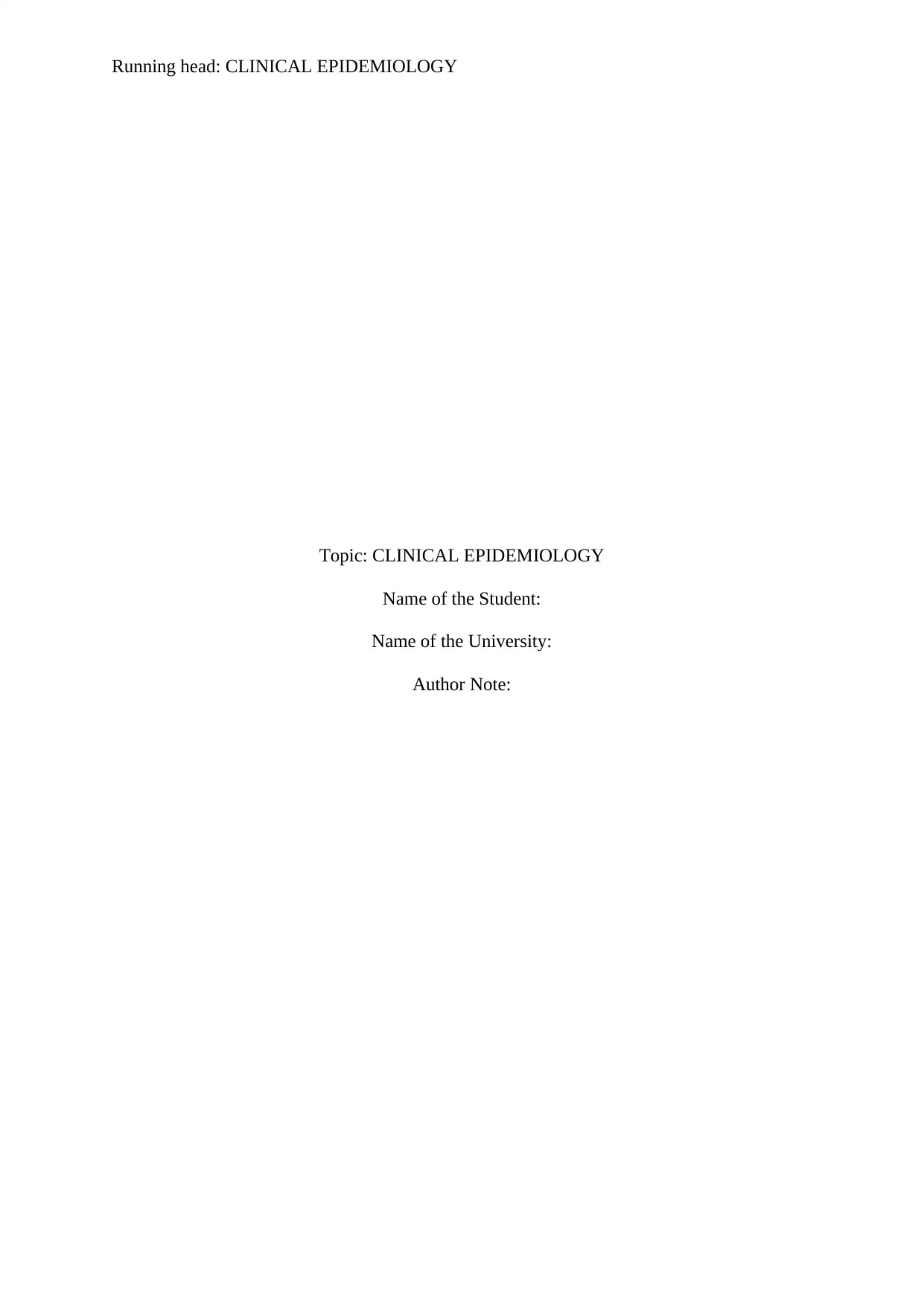
Running head: CLINICAL EPIDEMIOLOGY
Topic: CLINICAL EPIDEMIOLOGY
Name of the Student:
Name of the University:
Author Note:
Topic: CLINICAL EPIDEMIOLOGY
Name of the Student:
Name of the University:
Author Note:
Secure Best Marks with AI Grader
Need help grading? Try our AI Grader for instant feedback on your assignments.
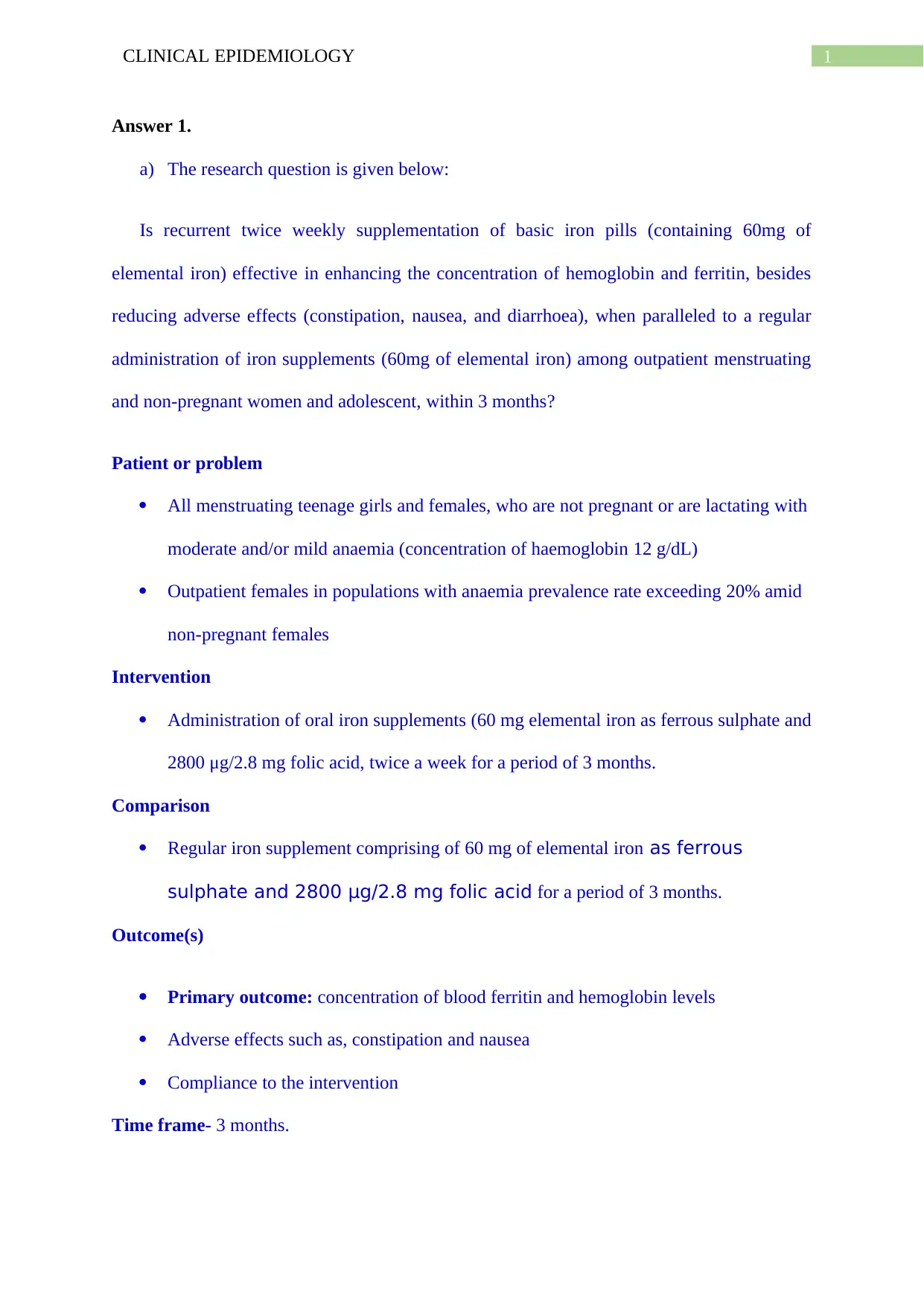
1CLINICAL EPIDEMIOLOGY
Answer 1.
a) The research question is given below:
Is recurrent twice weekly supplementation of basic iron pills (containing 60mg of
elemental iron) effective in enhancing the concentration of hemoglobin and ferritin, besides
reducing adverse effects (constipation, nausea, and diarrhoea), when paralleled to a regular
administration of iron supplements (60mg of elemental iron) among outpatient menstruating
and non-pregnant women and adolescent, within 3 months?
Patient or problem
All menstruating teenage girls and females, who are not pregnant or are lactating with
moderate and/or mild anaemia (concentration of haemoglobin 12 g/dL)
Outpatient females in populations with anaemia prevalence rate exceeding 20% amid
non-pregnant females
Intervention
Administration of oral iron supplements (60 mg elemental iron as ferrous sulphate and
2800 μg/2.8 mg folic acid, twice a week for a period of 3 months.
Comparison
Regular iron supplement comprising of 60 mg of elemental iron as ferrous
sulphate and 2800 μg/2.8 mg folic acid for a period of 3 months.
Outcome(s)
Primary outcome: concentration of blood ferritin and hemoglobin levels
Adverse effects such as, constipation and nausea
Compliance to the intervention
Time frame- 3 months.
Answer 1.
a) The research question is given below:
Is recurrent twice weekly supplementation of basic iron pills (containing 60mg of
elemental iron) effective in enhancing the concentration of hemoglobin and ferritin, besides
reducing adverse effects (constipation, nausea, and diarrhoea), when paralleled to a regular
administration of iron supplements (60mg of elemental iron) among outpatient menstruating
and non-pregnant women and adolescent, within 3 months?
Patient or problem
All menstruating teenage girls and females, who are not pregnant or are lactating with
moderate and/or mild anaemia (concentration of haemoglobin 12 g/dL)
Outpatient females in populations with anaemia prevalence rate exceeding 20% amid
non-pregnant females
Intervention
Administration of oral iron supplements (60 mg elemental iron as ferrous sulphate and
2800 μg/2.8 mg folic acid, twice a week for a period of 3 months.
Comparison
Regular iron supplement comprising of 60 mg of elemental iron as ferrous
sulphate and 2800 μg/2.8 mg folic acid for a period of 3 months.
Outcome(s)
Primary outcome: concentration of blood ferritin and hemoglobin levels
Adverse effects such as, constipation and nausea
Compliance to the intervention
Time frame- 3 months.
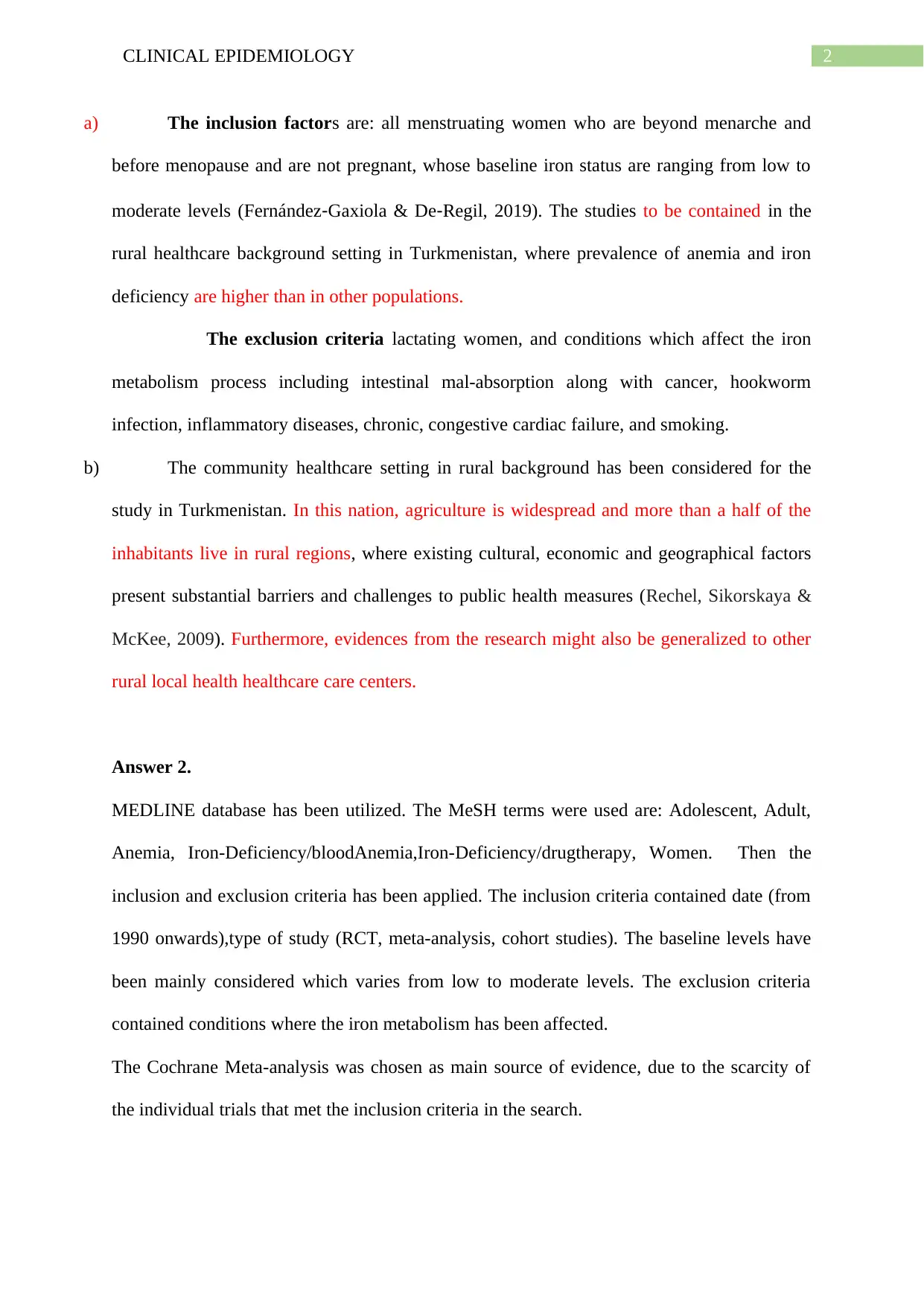
2CLINICAL EPIDEMIOLOGY
a) The inclusion factors are: all menstruating women who are beyond menarche and
before menopause and are not pregnant, whose baseline iron status are ranging from low to
moderate levels (Fernández‐Gaxiola & De‐Regil, 2019). The studies to be contained in the
rural healthcare background setting in Turkmenistan, where prevalence of anemia and iron
deficiency are higher than in other populations.
The exclusion criteria lactating women, and conditions which affect the iron
metabolism process including intestinal mal-absorption along with cancer, hookworm
infection, inflammatory diseases, chronic, congestive cardiac failure, and smoking.
b) The community healthcare setting in rural background has been considered for the
study in Turkmenistan. In this nation, agriculture is widespread and more than a half of the
inhabitants live in rural regions, where existing cultural, economic and geographical factors
present substantial barriers and challenges to public health measures (Rechel, Sikorskaya &
McKee, 2009). Furthermore, evidences from the research might also be generalized to other
rural local health healthcare care centers.
Answer 2.
MEDLINE database has been utilized. The MeSH terms were used are: Adolescent, Adult,
Anemia, Iron-Deficiency/bloodAnemia,Iron-Deficiency/drugtherapy, Women. Then the
inclusion and exclusion criteria has been applied. The inclusion criteria contained date (from
1990 onwards),type of study (RCT, meta-analysis, cohort studies). The baseline levels have
been mainly considered which varies from low to moderate levels. The exclusion criteria
contained conditions where the iron metabolism has been affected.
The Cochrane Meta-analysis was chosen as main source of evidence, due to the scarcity of
the individual trials that met the inclusion criteria in the search.
a) The inclusion factors are: all menstruating women who are beyond menarche and
before menopause and are not pregnant, whose baseline iron status are ranging from low to
moderate levels (Fernández‐Gaxiola & De‐Regil, 2019). The studies to be contained in the
rural healthcare background setting in Turkmenistan, where prevalence of anemia and iron
deficiency are higher than in other populations.
The exclusion criteria lactating women, and conditions which affect the iron
metabolism process including intestinal mal-absorption along with cancer, hookworm
infection, inflammatory diseases, chronic, congestive cardiac failure, and smoking.
b) The community healthcare setting in rural background has been considered for the
study in Turkmenistan. In this nation, agriculture is widespread and more than a half of the
inhabitants live in rural regions, where existing cultural, economic and geographical factors
present substantial barriers and challenges to public health measures (Rechel, Sikorskaya &
McKee, 2009). Furthermore, evidences from the research might also be generalized to other
rural local health healthcare care centers.
Answer 2.
MEDLINE database has been utilized. The MeSH terms were used are: Adolescent, Adult,
Anemia, Iron-Deficiency/bloodAnemia,Iron-Deficiency/drugtherapy, Women. Then the
inclusion and exclusion criteria has been applied. The inclusion criteria contained date (from
1990 onwards),type of study (RCT, meta-analysis, cohort studies). The baseline levels have
been mainly considered which varies from low to moderate levels. The exclusion criteria
contained conditions where the iron metabolism has been affected.
The Cochrane Meta-analysis was chosen as main source of evidence, due to the scarcity of
the individual trials that met the inclusion criteria in the search.
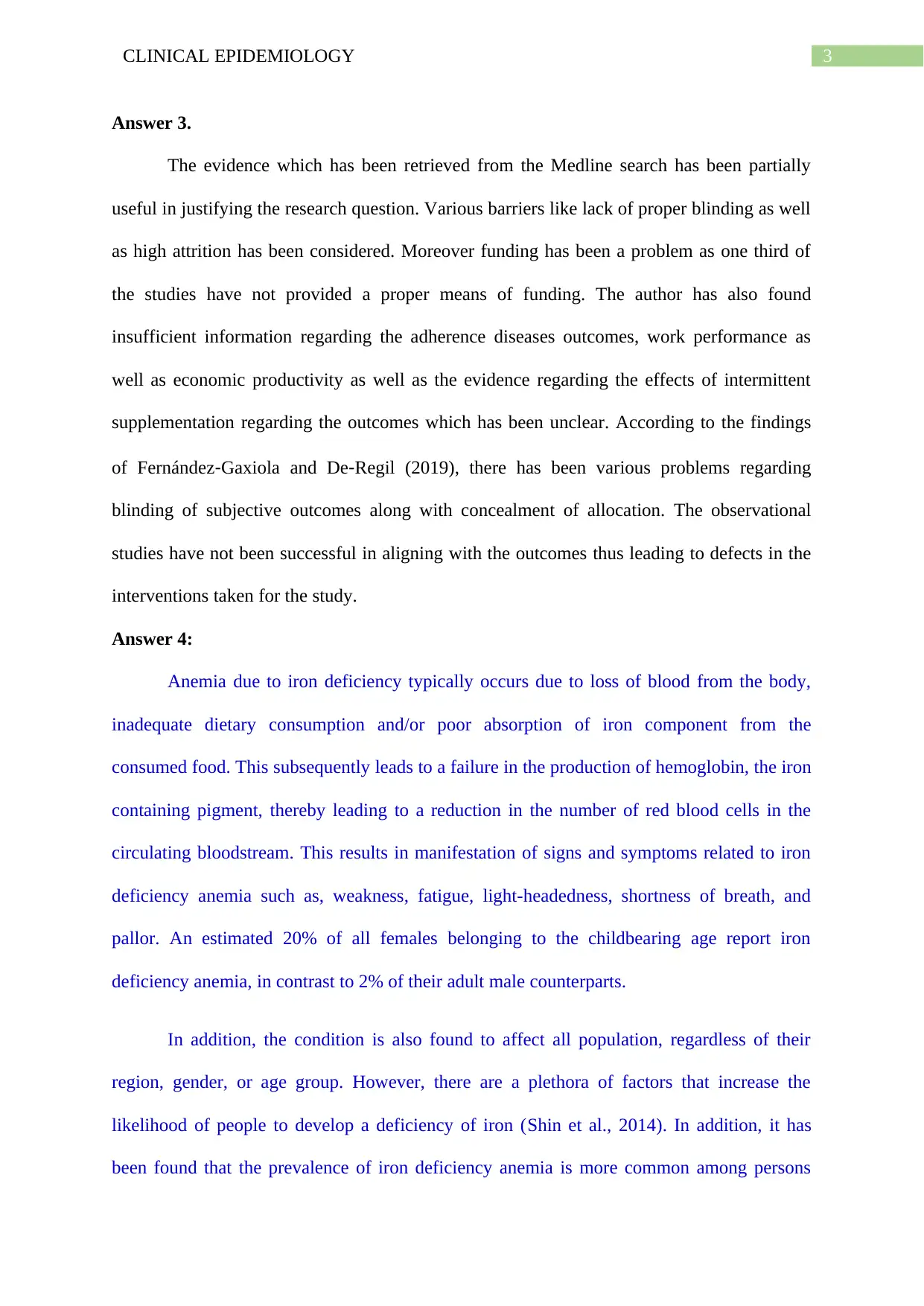
3CLINICAL EPIDEMIOLOGY
Answer 3.
The evidence which has been retrieved from the Medline search has been partially
useful in justifying the research question. Various barriers like lack of proper blinding as well
as high attrition has been considered. Moreover funding has been a problem as one third of
the studies have not provided a proper means of funding. The author has also found
insufficient information regarding the adherence diseases outcomes, work performance as
well as economic productivity as well as the evidence regarding the effects of intermittent
supplementation regarding the outcomes which has been unclear. According to the findings
of Fernández‐Gaxiola and De‐Regil (2019), there has been various problems regarding
blinding of subjective outcomes along with concealment of allocation. The observational
studies have not been successful in aligning with the outcomes thus leading to defects in the
interventions taken for the study.
Answer 4:
Anemia due to iron deficiency typically occurs due to loss of blood from the body,
inadequate dietary consumption and/or poor absorption of iron component from the
consumed food. This subsequently leads to a failure in the production of hemoglobin, the iron
containing pigment, thereby leading to a reduction in the number of red blood cells in the
circulating bloodstream. This results in manifestation of signs and symptoms related to iron
deficiency anemia such as, weakness, fatigue, light-headedness, shortness of breath, and
pallor. An estimated 20% of all females belonging to the childbearing age report iron
deficiency anemia, in contrast to 2% of their adult male counterparts.
In addition, the condition is also found to affect all population, regardless of their
region, gender, or age group. However, there are a plethora of factors that increase the
likelihood of people to develop a deficiency of iron (Shin et al., 2014). In addition, it has
been found that the prevalence of iron deficiency anemia is more common among persons
Answer 3.
The evidence which has been retrieved from the Medline search has been partially
useful in justifying the research question. Various barriers like lack of proper blinding as well
as high attrition has been considered. Moreover funding has been a problem as one third of
the studies have not provided a proper means of funding. The author has also found
insufficient information regarding the adherence diseases outcomes, work performance as
well as economic productivity as well as the evidence regarding the effects of intermittent
supplementation regarding the outcomes which has been unclear. According to the findings
of Fernández‐Gaxiola and De‐Regil (2019), there has been various problems regarding
blinding of subjective outcomes along with concealment of allocation. The observational
studies have not been successful in aligning with the outcomes thus leading to defects in the
interventions taken for the study.
Answer 4:
Anemia due to iron deficiency typically occurs due to loss of blood from the body,
inadequate dietary consumption and/or poor absorption of iron component from the
consumed food. This subsequently leads to a failure in the production of hemoglobin, the iron
containing pigment, thereby leading to a reduction in the number of red blood cells in the
circulating bloodstream. This results in manifestation of signs and symptoms related to iron
deficiency anemia such as, weakness, fatigue, light-headedness, shortness of breath, and
pallor. An estimated 20% of all females belonging to the childbearing age report iron
deficiency anemia, in contrast to 2% of their adult male counterparts.
In addition, the condition is also found to affect all population, regardless of their
region, gender, or age group. However, there are a plethora of factors that increase the
likelihood of people to develop a deficiency of iron (Shin et al., 2014). In addition, it has
been found that the prevalence of iron deficiency anemia is more common among persons
Secure Best Marks with AI Grader
Need help grading? Try our AI Grader for instant feedback on your assignments.
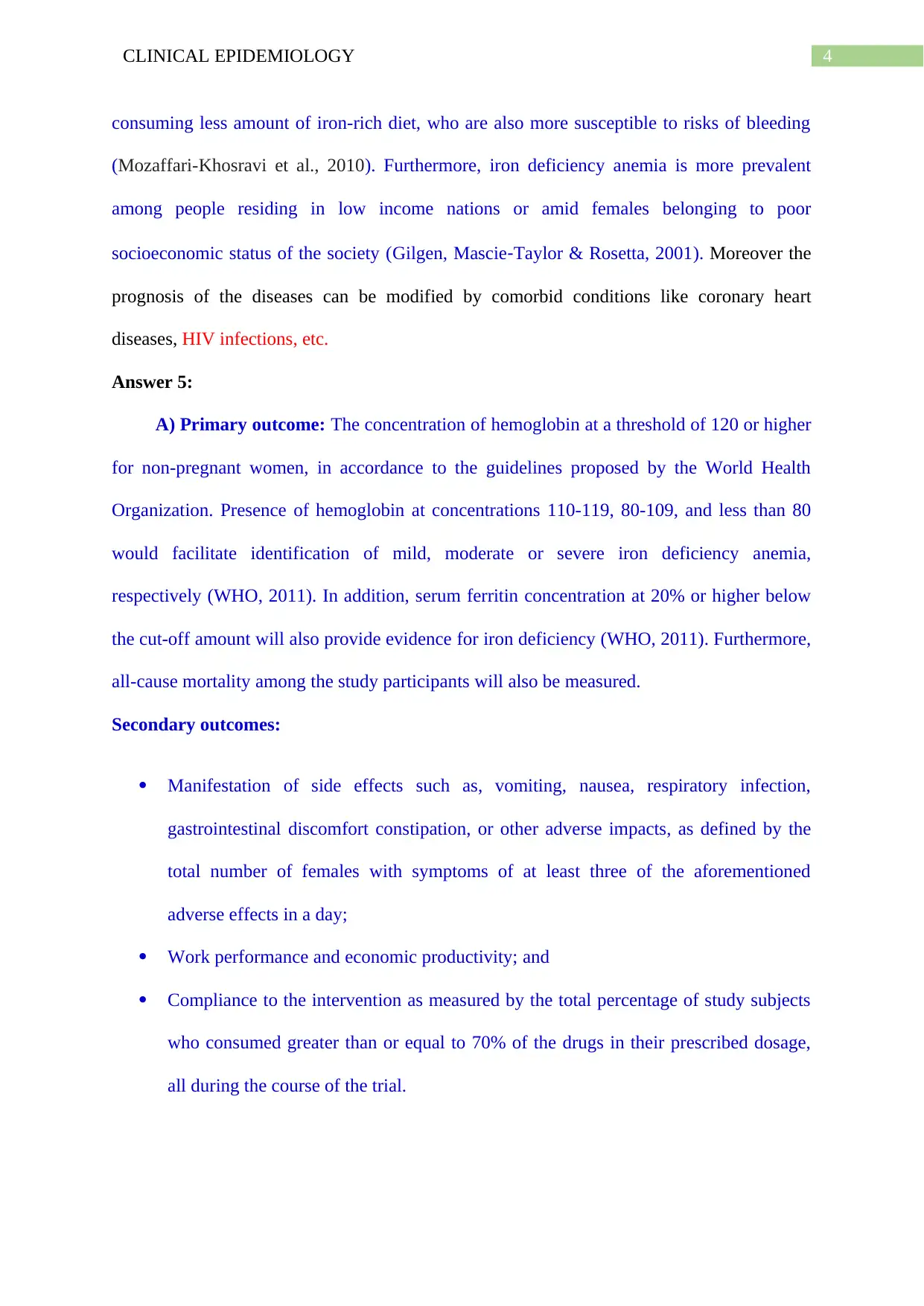
4CLINICAL EPIDEMIOLOGY
consuming less amount of iron-rich diet, who are also more susceptible to risks of bleeding
(Mozaffari-Khosravi et al., 2010). Furthermore, iron deficiency anemia is more prevalent
among people residing in low income nations or amid females belonging to poor
socioeconomic status of the society (Gilgen, Mascie‐Taylor & Rosetta, 2001). Moreover the
prognosis of the diseases can be modified by comorbid conditions like coronary heart
diseases, HIV infections, etc.
Answer 5:
A) Primary outcome: The concentration of hemoglobin at a threshold of 120 or higher
for non-pregnant women, in accordance to the guidelines proposed by the World Health
Organization. Presence of hemoglobin at concentrations 110-119, 80-109, and less than 80
would facilitate identification of mild, moderate or severe iron deficiency anemia,
respectively (WHO, 2011). In addition, serum ferritin concentration at 20% or higher below
the cut-off amount will also provide evidence for iron deficiency (WHO, 2011). Furthermore,
all-cause mortality among the study participants will also be measured.
Secondary outcomes:
Manifestation of side effects such as, vomiting, nausea, respiratory infection,
gastrointestinal discomfort constipation, or other adverse impacts, as defined by the
total number of females with symptoms of at least three of the aforementioned
adverse effects in a day;
Work performance and economic productivity; and
Compliance to the intervention as measured by the total percentage of study subjects
who consumed greater than or equal to 70% of the drugs in their prescribed dosage,
all during the course of the trial.
consuming less amount of iron-rich diet, who are also more susceptible to risks of bleeding
(Mozaffari-Khosravi et al., 2010). Furthermore, iron deficiency anemia is more prevalent
among people residing in low income nations or amid females belonging to poor
socioeconomic status of the society (Gilgen, Mascie‐Taylor & Rosetta, 2001). Moreover the
prognosis of the diseases can be modified by comorbid conditions like coronary heart
diseases, HIV infections, etc.
Answer 5:
A) Primary outcome: The concentration of hemoglobin at a threshold of 120 or higher
for non-pregnant women, in accordance to the guidelines proposed by the World Health
Organization. Presence of hemoglobin at concentrations 110-119, 80-109, and less than 80
would facilitate identification of mild, moderate or severe iron deficiency anemia,
respectively (WHO, 2011). In addition, serum ferritin concentration at 20% or higher below
the cut-off amount will also provide evidence for iron deficiency (WHO, 2011). Furthermore,
all-cause mortality among the study participants will also be measured.
Secondary outcomes:
Manifestation of side effects such as, vomiting, nausea, respiratory infection,
gastrointestinal discomfort constipation, or other adverse impacts, as defined by the
total number of females with symptoms of at least three of the aforementioned
adverse effects in a day;
Work performance and economic productivity; and
Compliance to the intervention as measured by the total percentage of study subjects
who consumed greater than or equal to 70% of the drugs in their prescribed dosage,
all during the course of the trial.
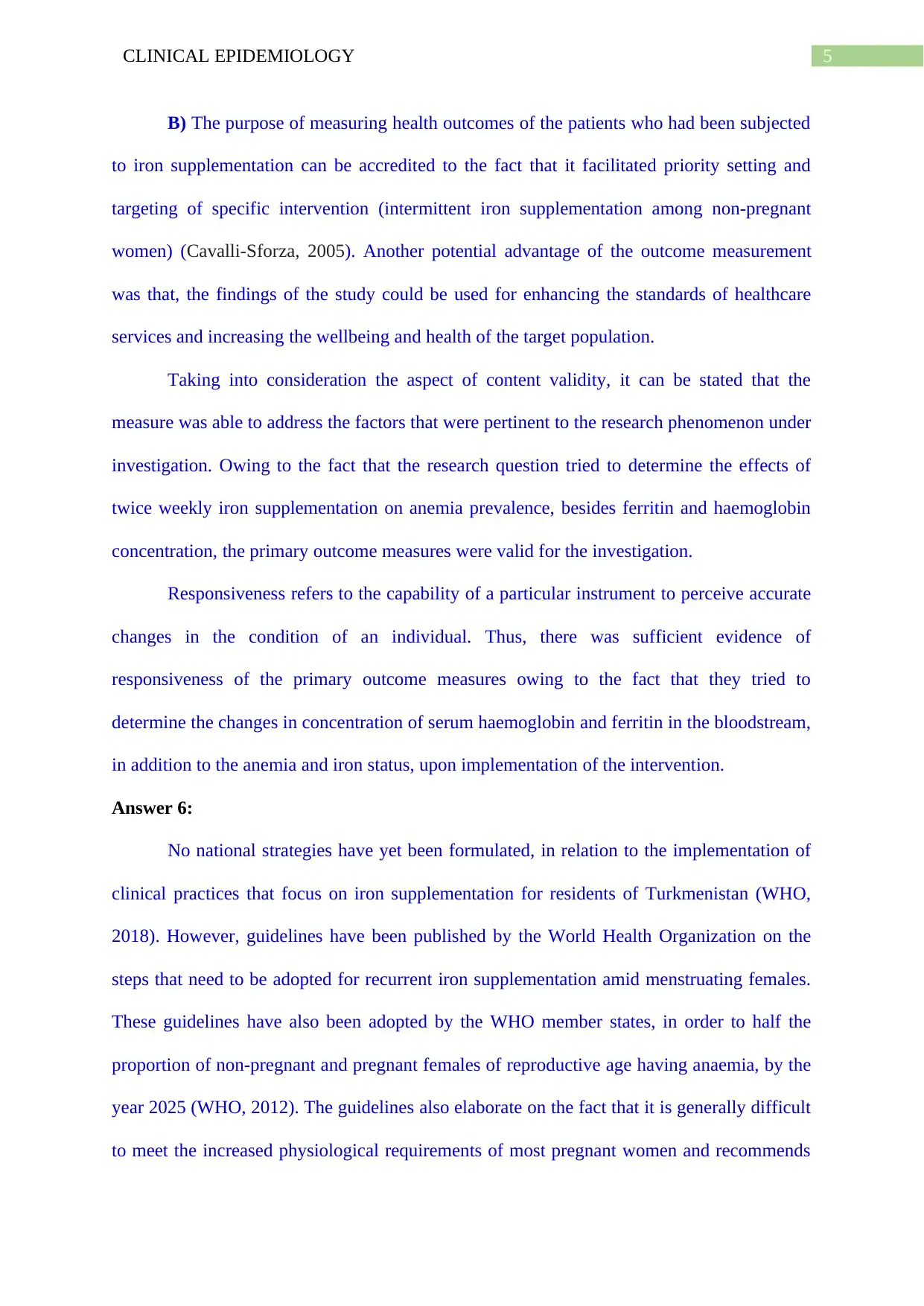
5CLINICAL EPIDEMIOLOGY
B) The purpose of measuring health outcomes of the patients who had been subjected
to iron supplementation can be accredited to the fact that it facilitated priority setting and
targeting of specific intervention (intermittent iron supplementation among non-pregnant
women) (Cavalli-Sforza, 2005). Another potential advantage of the outcome measurement
was that, the findings of the study could be used for enhancing the standards of healthcare
services and increasing the wellbeing and health of the target population.
Taking into consideration the aspect of content validity, it can be stated that the
measure was able to address the factors that were pertinent to the research phenomenon under
investigation. Owing to the fact that the research question tried to determine the effects of
twice weekly iron supplementation on anemia prevalence, besides ferritin and haemoglobin
concentration, the primary outcome measures were valid for the investigation.
Responsiveness refers to the capability of a particular instrument to perceive accurate
changes in the condition of an individual. Thus, there was sufficient evidence of
responsiveness of the primary outcome measures owing to the fact that they tried to
determine the changes in concentration of serum haemoglobin and ferritin in the bloodstream,
in addition to the anemia and iron status, upon implementation of the intervention.
Answer 6:
No national strategies have yet been formulated, in relation to the implementation of
clinical practices that focus on iron supplementation for residents of Turkmenistan (WHO,
2018). However, guidelines have been published by the World Health Organization on the
steps that need to be adopted for recurrent iron supplementation amid menstruating females.
These guidelines have also been adopted by the WHO member states, in order to half the
proportion of non-pregnant and pregnant females of reproductive age having anaemia, by the
year 2025 (WHO, 2012). The guidelines also elaborate on the fact that it is generally difficult
to meet the increased physiological requirements of most pregnant women and recommends
B) The purpose of measuring health outcomes of the patients who had been subjected
to iron supplementation can be accredited to the fact that it facilitated priority setting and
targeting of specific intervention (intermittent iron supplementation among non-pregnant
women) (Cavalli-Sforza, 2005). Another potential advantage of the outcome measurement
was that, the findings of the study could be used for enhancing the standards of healthcare
services and increasing the wellbeing and health of the target population.
Taking into consideration the aspect of content validity, it can be stated that the
measure was able to address the factors that were pertinent to the research phenomenon under
investigation. Owing to the fact that the research question tried to determine the effects of
twice weekly iron supplementation on anemia prevalence, besides ferritin and haemoglobin
concentration, the primary outcome measures were valid for the investigation.
Responsiveness refers to the capability of a particular instrument to perceive accurate
changes in the condition of an individual. Thus, there was sufficient evidence of
responsiveness of the primary outcome measures owing to the fact that they tried to
determine the changes in concentration of serum haemoglobin and ferritin in the bloodstream,
in addition to the anemia and iron status, upon implementation of the intervention.
Answer 6:
No national strategies have yet been formulated, in relation to the implementation of
clinical practices that focus on iron supplementation for residents of Turkmenistan (WHO,
2018). However, guidelines have been published by the World Health Organization on the
steps that need to be adopted for recurrent iron supplementation amid menstruating females.
These guidelines have also been adopted by the WHO member states, in order to half the
proportion of non-pregnant and pregnant females of reproductive age having anaemia, by the
year 2025 (WHO, 2012). The guidelines also elaborate on the fact that it is generally difficult
to meet the increased physiological requirements of most pregnant women and recommends
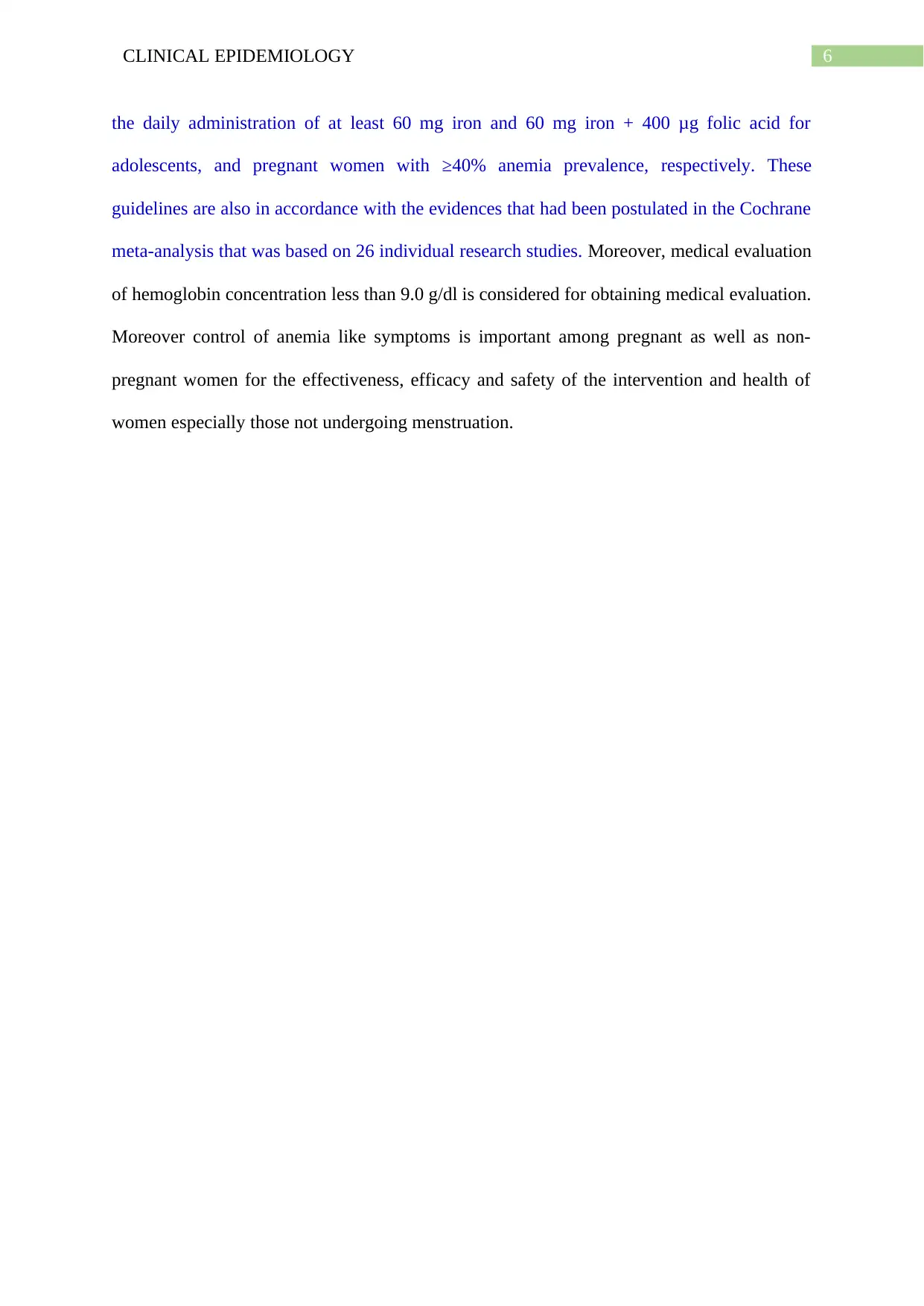
6CLINICAL EPIDEMIOLOGY
the daily administration of at least 60 mg iron and 60 mg iron + 400 μg folic acid for
adolescents, and pregnant women with ≥40% anemia prevalence, respectively. These
guidelines are also in accordance with the evidences that had been postulated in the Cochrane
meta-analysis that was based on 26 individual research studies. Moreover, medical evaluation
of hemoglobin concentration less than 9.0 g/dl is considered for obtaining medical evaluation.
Moreover control of anemia like symptoms is important among pregnant as well as non-
pregnant women for the effectiveness, efficacy and safety of the intervention and health of
women especially those not undergoing menstruation.
the daily administration of at least 60 mg iron and 60 mg iron + 400 μg folic acid for
adolescents, and pregnant women with ≥40% anemia prevalence, respectively. These
guidelines are also in accordance with the evidences that had been postulated in the Cochrane
meta-analysis that was based on 26 individual research studies. Moreover, medical evaluation
of hemoglobin concentration less than 9.0 g/dl is considered for obtaining medical evaluation.
Moreover control of anemia like symptoms is important among pregnant as well as non-
pregnant women for the effectiveness, efficacy and safety of the intervention and health of
women especially those not undergoing menstruation.
Paraphrase This Document
Need a fresh take? Get an instant paraphrase of this document with our AI Paraphraser
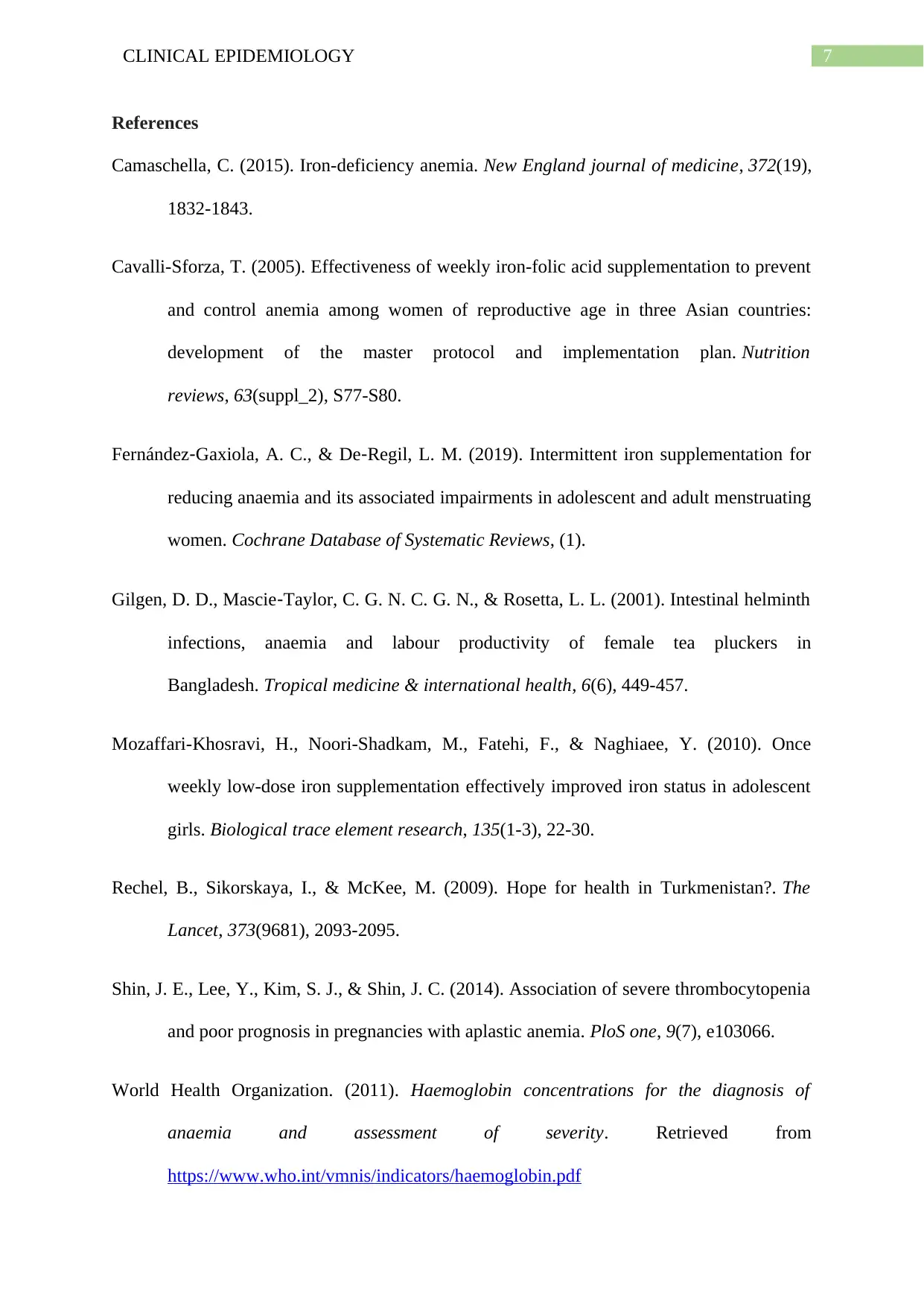
7CLINICAL EPIDEMIOLOGY
References
Camaschella, C. (2015). Iron-deficiency anemia. New England journal of medicine, 372(19),
1832-1843.
Cavalli-Sforza, T. (2005). Effectiveness of weekly iron-folic acid supplementation to prevent
and control anemia among women of reproductive age in three Asian countries:
development of the master protocol and implementation plan. Nutrition
reviews, 63(suppl_2), S77-S80.
Fernández‐Gaxiola, A. C., & De‐Regil, L. M. (2019). Intermittent iron supplementation for
reducing anaemia and its associated impairments in adolescent and adult menstruating
women. Cochrane Database of Systematic Reviews, (1).
Gilgen, D. D., Mascie‐Taylor, C. G. N. C. G. N., & Rosetta, L. L. (2001). Intestinal helminth
infections, anaemia and labour productivity of female tea pluckers in
Bangladesh. Tropical medicine & international health, 6(6), 449-457.
Mozaffari-Khosravi, H., Noori-Shadkam, M., Fatehi, F., & Naghiaee, Y. (2010). Once
weekly low-dose iron supplementation effectively improved iron status in adolescent
girls. Biological trace element research, 135(1-3), 22-30.
Rechel, B., Sikorskaya, I., & McKee, M. (2009). Hope for health in Turkmenistan?. The
Lancet, 373(9681), 2093-2095.
Shin, J. E., Lee, Y., Kim, S. J., & Shin, J. C. (2014). Association of severe thrombocytopenia
and poor prognosis in pregnancies with aplastic anemia. PloS one, 9(7), e103066.
World Health Organization. (2011). Haemoglobin concentrations for the diagnosis of
anaemia and assessment of severity. Retrieved from
https://www.who.int/vmnis/indicators/haemoglobin.pdf
References
Camaschella, C. (2015). Iron-deficiency anemia. New England journal of medicine, 372(19),
1832-1843.
Cavalli-Sforza, T. (2005). Effectiveness of weekly iron-folic acid supplementation to prevent
and control anemia among women of reproductive age in three Asian countries:
development of the master protocol and implementation plan. Nutrition
reviews, 63(suppl_2), S77-S80.
Fernández‐Gaxiola, A. C., & De‐Regil, L. M. (2019). Intermittent iron supplementation for
reducing anaemia and its associated impairments in adolescent and adult menstruating
women. Cochrane Database of Systematic Reviews, (1).
Gilgen, D. D., Mascie‐Taylor, C. G. N. C. G. N., & Rosetta, L. L. (2001). Intestinal helminth
infections, anaemia and labour productivity of female tea pluckers in
Bangladesh. Tropical medicine & international health, 6(6), 449-457.
Mozaffari-Khosravi, H., Noori-Shadkam, M., Fatehi, F., & Naghiaee, Y. (2010). Once
weekly low-dose iron supplementation effectively improved iron status in adolescent
girls. Biological trace element research, 135(1-3), 22-30.
Rechel, B., Sikorskaya, I., & McKee, M. (2009). Hope for health in Turkmenistan?. The
Lancet, 373(9681), 2093-2095.
Shin, J. E., Lee, Y., Kim, S. J., & Shin, J. C. (2014). Association of severe thrombocytopenia
and poor prognosis in pregnancies with aplastic anemia. PloS one, 9(7), e103066.
World Health Organization. (2011). Haemoglobin concentrations for the diagnosis of
anaemia and assessment of severity. Retrieved from
https://www.who.int/vmnis/indicators/haemoglobin.pdf
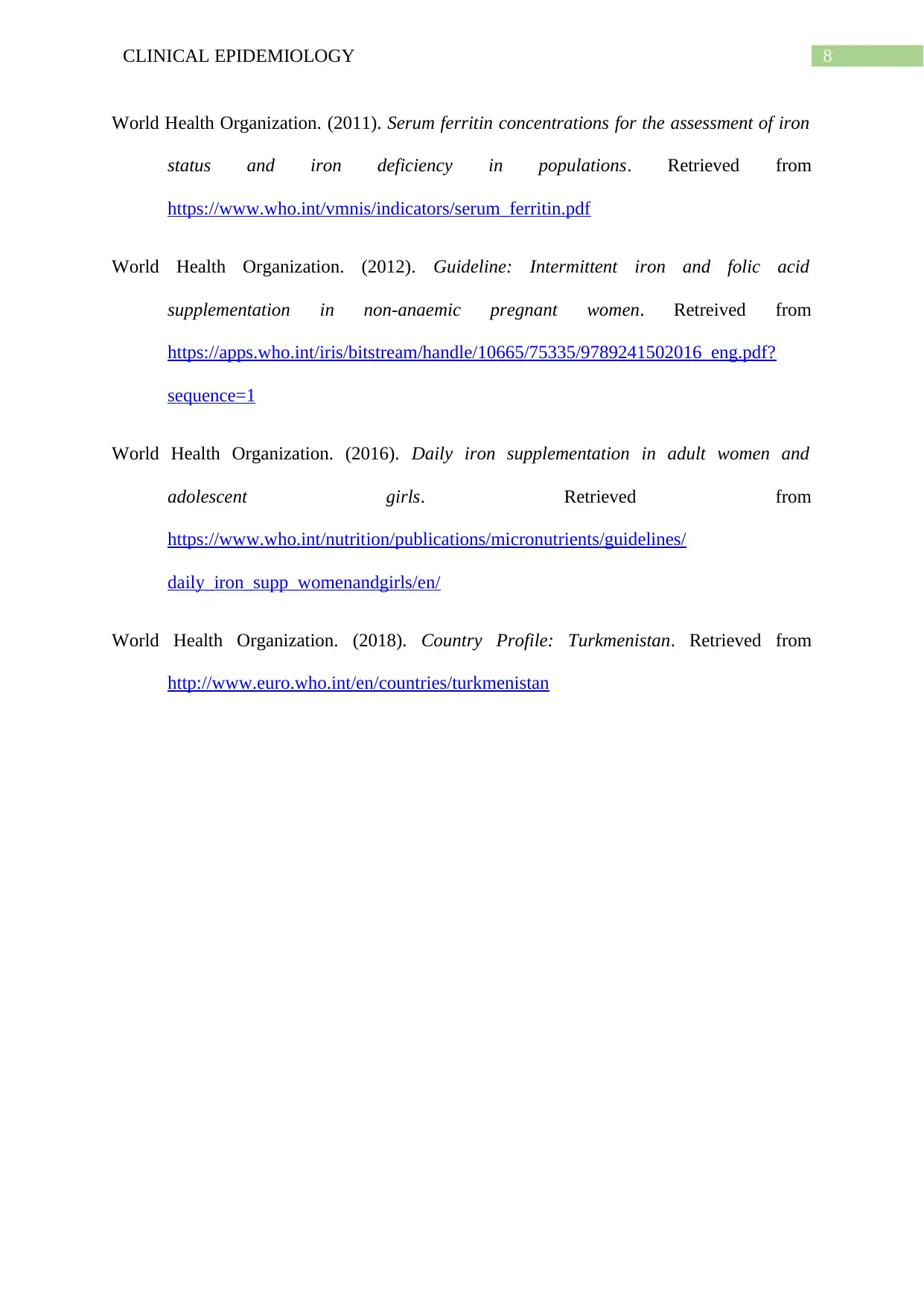
8CLINICAL EPIDEMIOLOGY
World Health Organization. (2011). Serum ferritin concentrations for the assessment of iron
status and iron deficiency in populations. Retrieved from
https://www.who.int/vmnis/indicators/serum_ferritin.pdf
World Health Organization. (2012). Guideline: Intermittent iron and folic acid
supplementation in non-anaemic pregnant women. Retreived from
https://apps.who.int/iris/bitstream/handle/10665/75335/9789241502016_eng.pdf?
sequence=1
World Health Organization. (2016). Daily iron supplementation in adult women and
adolescent girls. Retrieved from
https://www.who.int/nutrition/publications/micronutrients/guidelines/
daily_iron_supp_womenandgirls/en/
World Health Organization. (2018). Country Profile: Turkmenistan. Retrieved from
http://www.euro.who.int/en/countries/turkmenistan
World Health Organization. (2011). Serum ferritin concentrations for the assessment of iron
status and iron deficiency in populations. Retrieved from
https://www.who.int/vmnis/indicators/serum_ferritin.pdf
World Health Organization. (2012). Guideline: Intermittent iron and folic acid
supplementation in non-anaemic pregnant women. Retreived from
https://apps.who.int/iris/bitstream/handle/10665/75335/9789241502016_eng.pdf?
sequence=1
World Health Organization. (2016). Daily iron supplementation in adult women and
adolescent girls. Retrieved from
https://www.who.int/nutrition/publications/micronutrients/guidelines/
daily_iron_supp_womenandgirls/en/
World Health Organization. (2018). Country Profile: Turkmenistan. Retrieved from
http://www.euro.who.int/en/countries/turkmenistan
1 out of 9
Your All-in-One AI-Powered Toolkit for Academic Success.
+13062052269
info@desklib.com
Available 24*7 on WhatsApp / Email
![[object Object]](/_next/static/media/star-bottom.7253800d.svg)
Unlock your academic potential
© 2024 | Zucol Services PVT LTD | All rights reserved.